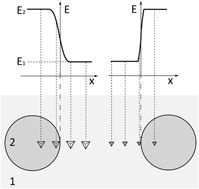Crossref Citations
This article has been cited by the following publications. This list is generated based on data provided by
Crossref.
Čech, Jaroslav
Haušild, Petr
Materna, Aleš
Matějíček, Jiří
Chicot, Didier
Iost, Alain
Montagne, Alex
and
Le Bourhis, Eric
2017.
Approche statistique pour identifier les propriétés mécaniques des phases individuelles à partir de données d’indentation.
Matériaux & Techniques,
Vol. 105,
Issue. 1,
p.
105.
Mercier, David
Vanhumbeeck, Jean-François
Caruso, Matteo
Eyndes, Xavier Vanden
Chicot, Didier
Iost, Alain
Montagne, Alex
and
Le Bourhis, Eric
2017.
Caractérisation mécanique par nanoindentation d’un revêtement composite à matrice nickel électrodéposé.
Matériaux & Techniques,
Vol. 105,
Issue. 1,
p.
106.
Haušild, Petr
Čech, Jaroslav
Karlík, Miroslav
Průša, Filip
Novák, Pavel
and
Kopeček, Jaromír
2018.
Nanoindentation Characterization of Mechanically Alloyed Fe-Al-Si Powders.
Key Engineering Materials,
Vol. 784,
Issue. ,
p.
15.
Mercier, David
Vanhumbeeck, Jean-François
Caruso, Matteo
Eynde, Xavier Vanden
and
Febvre, Mickaël
2019.
Microstructural and mechanical characterisation of electroplated nickel matrix composite coatings.
Surface Engineering,
Vol. 35,
Issue. 2,
p.
177.
Haušild, Petr
Čech, Jaroslav
Materna, Aleš
and
Matějíček, Jiří
2019.
Statistical treatment of grid indentation considering the effect of the interface and the microstructural length scale.
Mechanics of Materials,
Vol. 129,
Issue. ,
p.
99.
Argatov, Ivan I.
and
Sabina, Federico J.
2020.
Contact stiffness indentation tomography: Moduli-perturbation approach.
International Journal of Engineering Science,
Vol. 146,
Issue. ,
p.
103175.
Argatov, Ivan I.
Jin, Xiaoqing
and
Keer, Leon M.
2020.
Collective indentation as a novel strategy for mechanical palpation tomography.
Journal of the Mechanics and Physics of Solids,
Vol. 143,
Issue. ,
p.
104063.
Zeng, Fanlin
Malzbender, Jürgen
Baumann, Stefan
Schulze-Küppers, Falk
Krüger, Manja
Nijmeijer, Arian
Guillon, Olivier
and
Meulenberg, Wilhelm Albert
2020.
Micromechanical Characterization of Ce0.8Gd0.2O2‐δ–FeCo2O4 Dual Phase Oxygen Transport Membranes.
Advanced Engineering Materials,
Vol. 22,
Issue. 6,
Ma, Zhaoyang
Pathegama Gamage, Ranjith
and
Zhang, Chengpeng
2020.
Application of nanoindentation technology in rocks: a review.
Geomechanics and Geophysics for Geo-Energy and Geo-Resources,
Vol. 6,
Issue. 4,
Wenskat, Marc
Čižek, Jakub
Liedke, Maciej Oskar
Butterling, Maik
Bate, Christopher
Haušild, Petr
Hirschmann, Eric
Wagner, Andreas
and
Weise, Hans
2020.
Vacancy-Hydrogen Interaction in Niobium during Low-Temperature Baking.
Scientific Reports,
Vol. 10,
Issue. 1,
Luo, Shengmin
Wu, Yongkang
Li, Yucheng
Wang, Dongfang
Kim, Daeyoung
Song, Jinliang
and
Zhang, Guoping
2021.
Nanoindentation-enhanced screening of hydraulic fracturing fluid additives.
International Journal of Coal Geology,
Vol. 240,
Issue. ,
p.
103744.
Doubek, Pavel
Malíková, Lucie
and
Seitl, Stanislav
2022.
Analysis of the material properties in the vicinity of bi-material interface made by the laser cladded protective layer on the S960.
Procedia Structural Integrity,
Vol. 42,
Issue. ,
p.
1529.
Ezenwafor, Theresa
Anye, Vitalis
Madukwe, Jonathan
Amin, Said
Obayemi, John
Odusanya, Olushola
and
Soboyejo, Winston
2023.
Nanoindentation study of the viscoelastic properties of human triple negative breast cancer tissues: Implications for mechanical biomarkers.
Acta Biomaterialia,
Vol. 158,
Issue. ,
p.
374.
Doubek, Pavel
Malíková, Lucie
Miarka, Petr
and
Seitl, Stanislav
2023.
Laser cladded protective layer on the S960 Change of microhardness in the vicinity of the bi-material interface.
Procedia Structural Integrity,
Vol. 43,
Issue. ,
p.
101.
HAN, Lei
SHI, Xian
LIU, Ming
NI, HongJian
PANG, XueYu
WANG, Min
and
MA, TianShou
2023.
Micromechanical properties of laminated shale based on dot matrix technology.
SCIENTIA SINICA Physica, Mechanica & Astronomica,
Vol. 53,
Issue. 8,
p.
284611.
Zhang, Chen
Bos, Clémence
Sandfeld, Stefan
and
Schwaiger, Ruth
2024.
Unsupervised learning of nanoindentation data to infer microstructural details of complex materials.
Frontiers in Materials,
Vol. 11,
Issue. ,
Xu, Zhitong
Liu, Ming
Gao, Chenghui
and
Yang, Fuqian
2024.
Effects of ferrite and graphite phases on scratch characteristics of nodular cast iron.
Journal of Materials Research and Technology,
Vol. 30,
Issue. ,
p.
2257.
